Dia de los Muertos altar a sharing moment for Manor residents
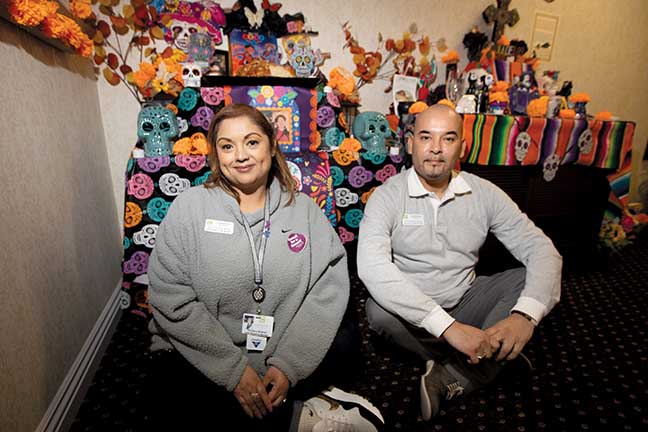
Claremont Manor’s two sales and marketing managers Veronica Moreno and Ralph Constantini created an elaborate Dia de los Muertos altar in a hall outside their offices. Moreno said they created the altar to teach the residents a little more about their shared culture and to celebrate Hispanic heritage month. Courier photo/Steven Felschundneff
by Steven Felschundneff | steven@claremont-courier.com
Elsie Eggen was so excited about Claremont Manor’s Dia de los Muertos altar that she wanted to share it with everyone. She pondered how best to get the word out, and so the 99-year-old decided to call the local newspaper.
Eggen remembers similar altars from her childhood in San Diego but remarked that the one at the Manor is so colorful and festive, it is unlike any she had seen before.
It was created by the Manor’s two sales and marketing managers, Veronica Moreno and Ralph Constantini, who said, to their knowledge, it’s the first ever at the retirement community.
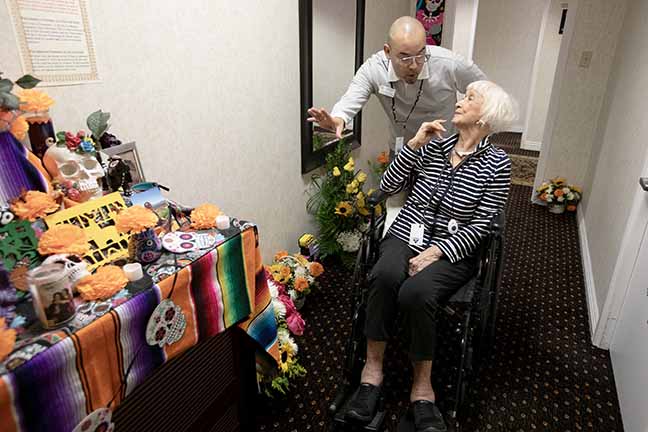
Claremont Manor sales and marketing manager Ralph Constantini speaks with resident Elsie Eggen about the Dia de los Muertos altar he and coworker Veronica Moreno created. Eggen was so excited about the altar she called the local newspaper to come have a look. Courier photo/Steven Felschundneff
“We both celebrate Dia de los Muertos at home and wanted to teach the residents a little more about our culture,” Moreno said. “We wanted to encourage diversity and celebrate Hispanic heritage month.”
Moreno said the vibrant colors remind people that death is a part of life and Dia de los Muertos is a time to celebrate life, not mourn the person’s passing. One can still remember the dead and honor them by placing a photograph or the name of a loved one who has died on the altar.
The items placed on the altar are called the ofrenda, the offering, and many hold special significance. The monarch butterfly’s fall migration coincides with Dia de los Muertos, so the mariposas are symbolic of the souls of loved ones who visit the living for a short time.
“Butterflies are a common symbol for life and death in many places, including indigenous cultures from pre-Hispanic times,” Constantini and Moreno wrote in a descriptive poster placed near the altar.
Other ofrenda include tapetes de arena, sand sculptures or tapestries that represent the final element, the earth; pan de muerto, bread of the dead, which is a popular sweet bread that is common on altars along with a favorite food of someone who has passed; marigolds, cempasuchil or flor de muerto, with their bright colors and fragrance are said to attract souls to the altar; and candles are illuminated to guide the spirits home.

The “ofrenda,” or offerings, on the Dia de los Muertos altar all carry different symbolic meanings. Courier photo/Steven Felschundneff
Moreno and Constantini hope that people will become inspired by the altar and will want to build their own.
“We have sisters here and one of them will have her own ofrenda with her loved ones on it,” Moreno said.
The Manor’s altar is mostly decorated with images of the dead who are in some way connected to Constantini and Moreno, but residents are invited to bring pictures of their own family and friends. The latest addition is a bulletin from a Manor resident’s recent memorial service.
The pair built the altar with two small tables in an equally small hallway that connects their offices. The location is a bit out of the way, but its closeness creates the illusion of being in a sacred temple. However, they said plans are being made to erect the altar in a more centrally located spot next year.
The altar is up for the entire month of October but the celebration itself takes place on the last day of October and the first two days of November. October 31 is considered a day of preparation and is also a day for the “little angels.”
“According to tradition the gates of heaven are opened at midnight on October 31st and the spirits of children can rejoin their families for 24 hours,” Constantini and Moreno wrote.
November 1 is the actual Dia de los Muertos when people welcome the souls of their deceased relatives back for a brief reunion. Moreno emphasized the day is not for mourning or sadness but a time to celebrate death as part of the human experience.
November 2, All Souls’ Day, which is celebrated by Christians throughout the world, is a day for prayers for the deceased and for souls that remain in purgatory.
“People remember their loved ones by visiting the cemetery, decorating their graves and lighting candles in their honor,” Constantini and Moreno wrote.
Claremont resident Constantini has been employed at Claremont Manor for 13 years and started out working in the kitchen but slowly moved his way up in the organization. Moreno, who lives in West Covina, has only been working at the Manor for a year but she has been in senior services for 25 years.
“This is so completely beautiful, so colorful,” Eggen said while viewing the ofrenda on a recent Thursday evening. “I have seen many before but not for years. This definitely brought back memories.”



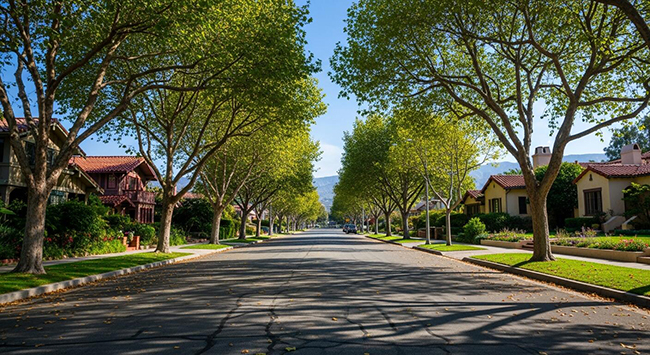
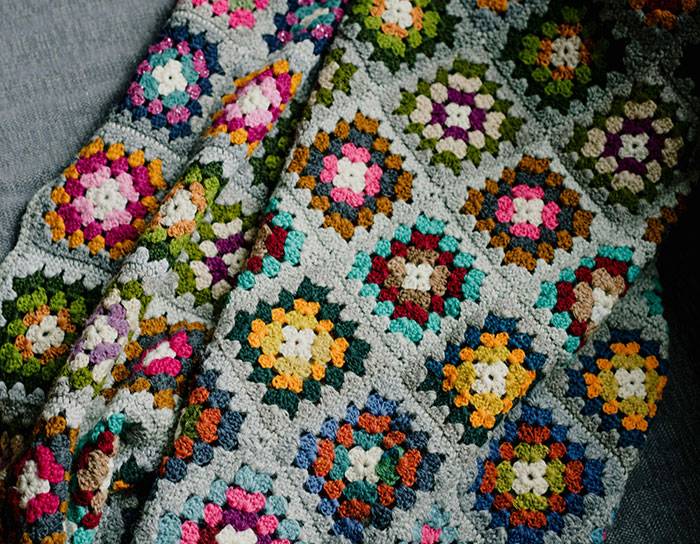
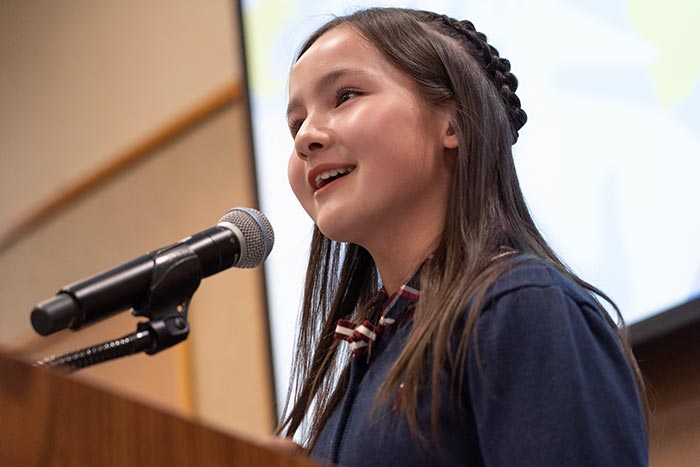

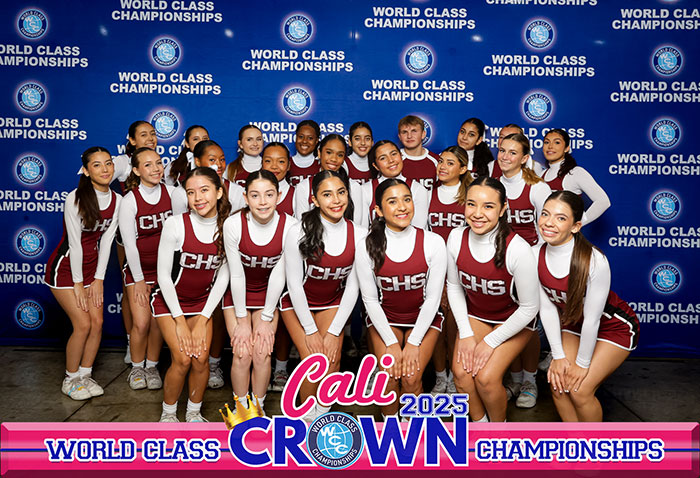


0 Comments